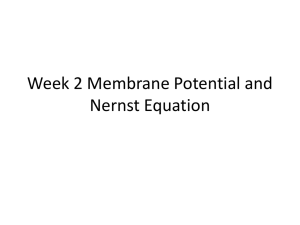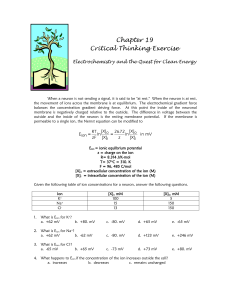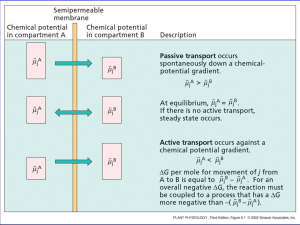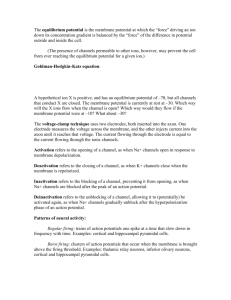I Neuroexcitability 1. Describe the basic structure of an ion channel
advertisement
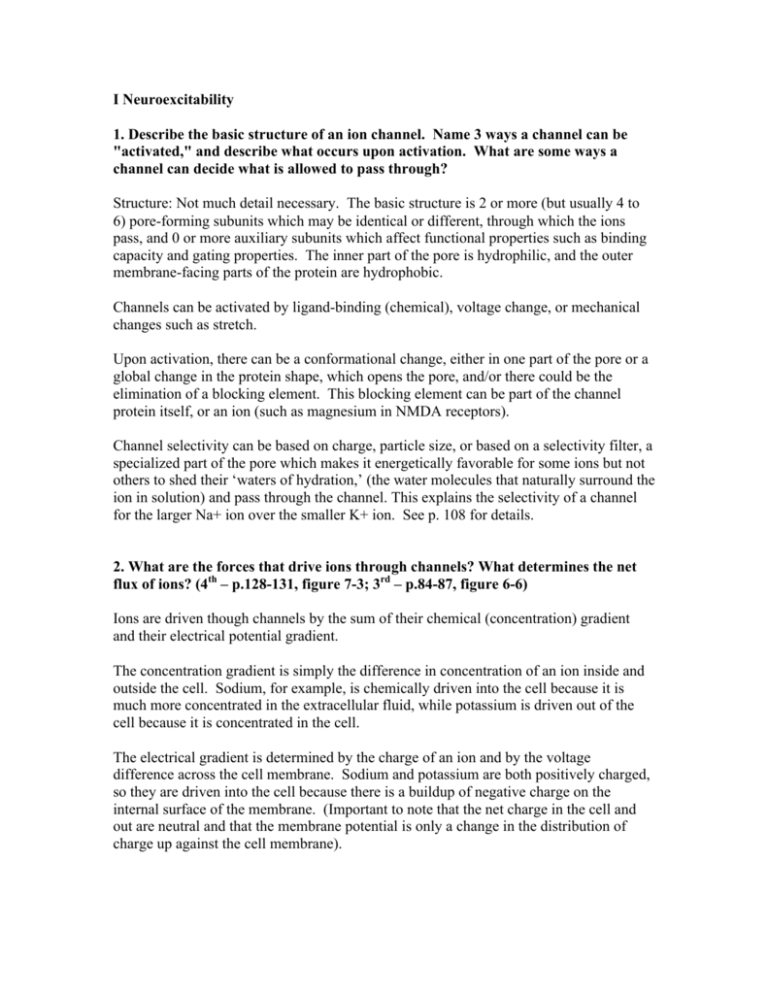
I Neuroexcitability 1. Describe the basic structure of an ion channel. Name 3 ways a channel can be "activated," and describe what occurs upon activation. What are some ways a channel can decide what is allowed to pass through? Structure: Not much detail necessary. The basic structure is 2 or more (but usually 4 to 6) pore-forming subunits which may be identical or different, through which the ions pass, and 0 or more auxiliary subunits which affect functional properties such as binding capacity and gating properties. The inner part of the pore is hydrophilic, and the outer membrane-facing parts of the protein are hydrophobic. Channels can be activated by ligand-binding (chemical), voltage change, or mechanical changes such as stretch. Upon activation, there can be a conformational change, either in one part of the pore or a global change in the protein shape, which opens the pore, and/or there could be the elimination of a blocking element. This blocking element can be part of the channel protein itself, or an ion (such as magnesium in NMDA receptors). Channel selectivity can be based on charge, particle size, or based on a selectivity filter, a specialized part of the pore which makes it energetically favorable for some ions but not others to shed their ‘waters of hydration,’ (the water molecules that naturally surround the ion in solution) and pass through the channel. This explains the selectivity of a channel for the larger Na+ ion over the smaller K+ ion. See p. 108 for details. 2. What are the forces that drive ions through channels? What determines the net flux of ions? (4th – p.128-131, figure 7-3; 3rd – p.84-87, figure 6-6) Ions are driven though channels by the sum of their chemical (concentration) gradient and their electrical potential gradient. The concentration gradient is simply the difference in concentration of an ion inside and outside the cell. Sodium, for example, is chemically driven into the cell because it is much more concentrated in the extracellular fluid, while potassium is driven out of the cell because it is concentrated in the cell. The electrical gradient is determined by the charge of an ion and by the voltage difference across the cell membrane. Sodium and potassium are both positively charged, so they are driven into the cell because there is a buildup of negative charge on the internal surface of the membrane. (Important to note that the net charge in the cell and out are neutral and that the membrane potential is only a change in the distribution of charge up against the cell membrane). The net flux flow for a given ion (I) is determined by the net driving force, which is the sum mentioned above, times the permeability of the channel to that particular ion. Permeability is determined by the abundance of non-gated channels for the specific ion. 3. Explain the Nernst Potential. What are the approximate Nernst potentials for K+, Na+, and Cl- in a neuronal cell. How are these ions' potentials calculated? How do the individual Nernst potentials determine the resting membrane potential? If the permeability to sodium was increased, how would this affect its Nernst potential? How about the resting potential of the cell?(4th- p.128; 3rd- p.84) Use the following concentrations: Inside the Outside the cell cell Na 440 50 + K+ Cl- 20 560 400 52 The Nernst potential is the membrane potential at which the electrical and chemical driving forces are equal for a specific ion. Note that at the Nernst potential, a dynamic equilibrium exists (this is actually a steady state balance), i.e., flow of the specific ion has not stopped, but net inward and outward movement are equal. The Nernst potentials for K+, Na+, and Cl- are calculated using the Nernst equation: For K+, E = RT x ln [K+]o Which can be simplified to: 58 log ([K+]o) ZF [K+]i Z ([K+]i) (K+ is a cation, so Z = +1; whereas Cl- is an anion, so Z = -1) For K+, E = 58 x log (20/400) = -75.5 mV For Na+, E = 58 x log (440/50) = +54.8 mV For Cl-, E = -58 x log (560/52) = -59.9 mV Note: for fast calculations notice hat if conc. outside is 10x that inside, E = 58/z, and if inside is 10x that outside E= -58/z The individual Nernst potentials determine the resting potential based on the relative permeabilities of the membrane to each ion. The resting potential will end up closest to the Nernst potential of the ion to which it is most permeable. Thus in our nerve cells, the resting potential ends up very close to the resting potential for potassium due to the high conductance (permeability) of this ion. The Goldman Equation is used to combine Nernst potentials and permeabilities and calculate the resting potential. (p132). Since ions are constantly leaking down their electrochemical gradient, the Na+/K+ ATPase-pump is necessary to maintain the concentrations of Na+ outside and K+ inside the cell, which are needed to maintain the resting membrane potential. Nernst potentials change only when the intracellular or extracellular concentrations are altered in selectively permeable membranes. They are not affected by permeability to the specific ion. Therefore a change in the permeability to sodium would not alter its Nernst potential, but would raise the resting potential closer to the Nernst potential of sodium. 4. Describe the activation of a voltage-gated sodium channel, including the resting, active and inactive (refractory) states. How can an elevated resting potential lead to a decreased action potential amplitude? Voltage-gated sodium channels have two gates, an activation gate (m-gate) and an inactivation gate (h-gate). At the resting potential, the activation gate is closed and the inactivation gate is open. Depolarization rapidly opens the m-gate and begins the slow closure of the h-gate. For a short time, the channel is open, until the h-gate fully closes. The membrane now repolarizes, closing the m-gate and slowly opening up the h-gate again. Voltage-gated sodium channels vary in their threshold of activation. If the resting potential is elevated above its normal number, some voltage-gated sodium channels will always be in the inactive state, having been activated by the current membrane potential. So if action potential is initiated at a higher than normal resting potential, its amplitude will be diminished because some sodium channels will be in the inactive state. 5. Describe the steps involved in initiation and resolution of an action potential. What types of ion channels are involved, and what role do they each play? An action potential is initiated by a depolarization of the cell membrane, which may be caused by the binding of a neurotransmitter to a ligand-gated sodium channel, for example, or by a sodium channel activated by stretch or some other chemical or mechanical stimulus. This initial depolarization is called a synaptic potential. If the initial depolarization is enough to reach “threshold,” an action potential is fired. About threshold: Every time a little sodium current comes through the membrane, raising its potential, two things happen which prevent the start of an action potential. First, there is an increase in the potassium driving force because of the change in membrane potential. Second, a few voltage-gated potassium channels open and bring the potential back down. Threshold is the point at which the rapidly-opening voltage-gated sodium channels cause inward sodium current to exceed outward potassium current. A large number of voltage-gated sodium channels will open, and the influx of sodium will open more voltage-gated sodium channels, and the membrane potential approaches the Nernst potential for sodium. The sodium channels gradually inactivate, decreasing the sodium conductance, and at the same time, voltage-gated potassium channels open, increasing the outflow of potassium and bringing the membrane potential back down toward the Nernst potential for potassium. There is a transient hyperpolarization, the ‘undershoot,’ after the action potential. This occurs because some of the voltage-gated potassium channels which opened during the action potential have not yet closed when the membrane potential returns to its normal resting value. The increased permeability to potassium compared to its normal permeability pushes the membrane potential closer to the Nernst potential for potassium. Remember, permeability affects the relative strength of an ion in pushing the membrane potential where it wants it to go. After the action potential, there is a refractory period which can be divided into two parts. In the absolute refractory period, most sodium channels are still inactivated so no stimulus can bring on an action potential. In the relative refractory period, some sodium channels are still inactive and there are still some open potassium channels, so a new action potential would require a very large stimulus. 6. The cell membrane is often compared to a capacitor. a) Draw a membrane and show how it acts as a capacitor. What variables determines capacitance? b) What effect does capacitance have on changes in membrane potential and on the propagation of an action potential? c) How have organisms evolved their capacitance to speed up their action potential propagation? (p142) A simple capacitor consists of 2 plates separated by a gap. In the case of the cell membrance, the plates are the intra- and extracellular surfaces of the membrane, and the membrane thickness itself is the gap. The membrane exhibits the behavior of a capacitor because the membrane potential rises and decays more slowly than sudden changes in current applied to it (with a simple resistor, the changes would be instantaneous). In effect, the membrane capacitance acts as a bucket with the voltage represented by how high the bucket is filled. If you have a big fat bucket (big capacitance), it takes longer to fill it to a certain height (achieve a certain voltage). If you have a very thin bucket (small capacitance) it reaches that height (voltage) more quickly. Mathematically, V=Q/C (if the capacitance is equal to 1, then a change in current results in an immediate and proportional change in voltage, i.e. a simple resistor. If the capacitance is greater than 1, as in the cell membrance, the voltage changes is slower and smaller.) Therefore, capacitance serves to slow down changes in membrane potential and, by extension, slow down the propagation of an action potential. Capacitance itself is determined by the equation C=A/d where A is the area of the plates and d is the size of the gap. Therefore cells with a bigger gap (a thicker membrane due to myelination) have a lower capacitance and propagate action potentials quicker. Saltatory conduction is a faster mode of action potential propagation in which action potentials are generated only at the nodes of Ranvier in a myelinated axon. 7. What is the length constant for action potential propagation? How do the components of the length constant affect propagation? How have cells' length constants evolved to have faster propagation? What is the mathematical relationship between axonal resistance, capacitance, and rate of passive current spread? (p143-148) The length constant describes how far a voltage change due to the injection of current will travel within an axon before it decays. So, big length constant = more propagation. (Lambda= square root of Rm/Ra) Rm = resistance of the membrane and Ra = resistance to current flow down the axon. So, the bigger the Rm and/or the smaller the Ra, the less current will escape from the axon across the membrane and the more will travel down it. Cells increase Rm by myelination and decrease Ra by increasing axon diameter. The rate of propagation of an action potential is inversely related to the product of capacitance and axonal resistance (C*Ra). SO, to increase rate, you want to decrease C*Ra. (p. 147) Note: Increasing axon diameter also increases capacitance by increasing the membrane surface area, remember from above that C=A/d. However, the Ra decreases in proportion to the square of the increased diameter while C increases in direct proportion to the diameter, (resistance goes down faster than capacitance goes up) so the net effect is to decrease C*Ra. A bigger length constant also increases spatial summation within a neuron, so that two inputs far away from each other can sum together to possibly reach threshold. It has no effect on temporal summation, which is influenced only by the time constant. 8. Draw an electrical circuit (resistors, capacitors, etc.) representing a neuron at rest. Include ion permeabilities, Nernst potentials, membrane capacitance, and indicate charge flow for Na, K, Cl. (4th- p. 135, figure 7-10; and p147) Referring to figure 7-10, Cm represents the membrane itself as a capacitor (see above for explanation). The resistors / battery combinations in parallel represent the ion channels and Nernst potentials for Cl, K, and Na. Note the current flowing across the Na and K channels: in a cell at rest, the K current would be much larger. The two current generators in the diagram represent the Na/K pump which is working to counteract the constant leak of current across the Na and K channels. Finally, this figure only represents a tiny patch of membrane. To describe an entire axon, multiple segments like this one should be linked up in parallel with resistors that represent the axonal resistance (Ra). 9. What is the difference between patch clamping and voltage clamping? What is each one used to study? How can we use TTX and TEA to aid these studies? (p152153, p162) In a voltage clamp experiment, electrodes are place inside and outside the cell. The membrane potential is then maintained at any given voltage by adding or withdrawing current as needed (using a negative feedback circuit). The current needed to maintain the membrane at a given voltage indicates how much ion flow there is through the open channels. We can then assess the conductance of an single type of ion channel by inactivating the other types. TEA is used to block K+ channels, TTX is used to block voltage-gated Na+ channels. In the voltage clamp experiments, the summed activity of many, many channels is measured. In contrast, the patch clamp allows the current at a single channel to be measured. A micropipette is placed over the channel and current is read between the inside of the cell (electrode puncturing the cell membrane) and the salt solution inside the micropipette. Patch clamping (p. 192, 195) allowed researchers to see that current is transmitted through channels in an all-or-none fashion. Therefore, the gradations of membrane current are created simply by the number of channels open at any given time. II. Synaptic Transmission 1. There are two types of synapses, electrical and chemical. If you inject current into the presynaptic cell, through which channels will it pass in the electrical synapse? Chemical synapse? How does transmission across each type of synapse result in an action potential in the postsynaptic cell? [See figure10-1, p 176, and text, p176-177] Remember for both synapses that the current will always travel in the path of least resistance to its flow. The least-resistant paths are different for each synapse. Electrical: some escapes through resting ion channels [remember that when we talk about current, we are also thinking about ion movement], others through gap junctions (direct low resistant, high conductance path) into postsynaptic cell. There, more escapes out of the ion channels. If depolarization exceeds threshold, an action potential will be generated. Chemical: ALL through ion channels in presynaptic cell (much less resistance than crossing the external membrane of the postsynaptic cell to get in). But, this results in depolarization of the cell which activates neurotransmitter release from synaptic vesicles, which can then travel across synaptic cleft to postsynaptic cell, bind to receptors*, open ion channels, change membrane potential, and if depolarization exceeds threshold, an action potential will be generated. 2. Describe the difference between ionotrophic and metabotrophic receptors and give one example of each. IONOTROPIC - receptor and ion channel in same macromolecule—transmitter binding opens channel. One example is the Nicotinic Ach receptor found at the neuro-muscular junction. Other examples: Glutamate, Glycine, GABA, … METABOTROPIC - coupled to second messengers (eg. G proteins) that indirectly influence channel opening. Examples: Muscarinic Ach receptor; Adrenergic receptors 3. Functional properties of the electrical and chemical synapses A. Which synapse is used in fast, defensive reflexes in the aplysia? Why? Electrical because they’re faster—there is a rapid coupling between pre and post-synaptic cells. In chemical, it takes time for the neurotransmitter to be released, travel across, bind to receptor, etc., so it’s slower. B. Which synapse is used when one wants amplification of the signal? Why? Chemical. This is because the presynaptic cell releases a large amount of neurotransmitters that can combine with many postsynaptic receptors and open many ion channels. C. Which synapse is used when it is necessary for a large population of neurons to be acting as a single unit? Why? (p. 180) Electrical. Because current flows across the membranes of all electrically coupled cells at the same time, several small cells can act coordinately as one large cell and will fire synchronously. This is similar to the cardiac muscle cells firing in sequence. [Also, because the cells are coupled, their total resistance is smaller than the resistance of a single cell, but a larger current is needed to depolarize them to threshold. Delta V = Delta I x R] D. Which synapse allows for transmission from a smaller cell to a larger cell? Chemical (ie, this happens in the NMJ). In the chemical synapse a small amount of neurotransmitter can create a large post synaptic depolarization depending on the number of post synaptic receptors and ion channels as well as the half life of the neurotransmitter in the synaptic cleft. In electrical synapses, the signal must go from a larger cell to smaller cell. This is because (p177) the current that depolarizes the postsynaptic cell is generated directly by the voltage-gated ion channels of the presynaptic cell. Thus these channels must not only depolarize the presynaptic cell, but must generate enough ionic current to produce a potential change in the postsynaptic cell. For such a large current to be generated, the presynaptic cell must have a lot of ion channels, and therefore, must be relatively large. The postsynaptic cell must be relatively small because, as seen in Ohm’s law (∆ V = ∆I x Rm), in response to a given current (∆I), there will be a greater change in potential (∆V) if there is a higher input resistance, and small cells will have a larger resistance than a larger cell. 4. Stimulation of which of the following two nerves is more likely to cause a post synaptic action potential: 1) A single excitatory CNS neuron 2) a motoneuron at the NMJ? The amplitude of the end-plate potential in a muscle cell is very large – usually stimulation of a single motor cell produces a synaptic potential of about 70mV. This is usually large enough to activate voltage-activated Na+ channels to propagate an action potential. In contrast, CNS presynaptic neurons produce postsynaptic potentials of less than 1mV in amplitude, so input from multiple presynaptic neurons is necessary to generate an action potential in the CNS. (p 190) 5. The reversal potential at the motor end-plate is 0mV. Assuming virtually all channels at the end plate to be Ach-gated channels, what specific property of Achgated channels does this value for resting potential tell us about? The reversal potential is the potential at which the net ionic current across the membrane is zero. It is a way of experimentally measuring the EEPSP (the battery resulting from the concentration gradients of ions conducted through a Ach-gated channels at the end-plate). According to the equation IEPSP = gEPSP X (Vm – EEPSP), if the influx of Na+ were solely responsible for the end-plate potential, the reversal potential would be +55mV (all current at that point would be 0. Since the reversal potential is 0mV (which represents a weighted average for the equilibrium potentials of BOTH Na+ and K+), Ach-gated channels must be permeable to BOTH of these ions. This permeability to two different ions is a property that separates Ach-gated channels from many of the other voltage-gated channels (detailed explanation on p 191-192). 6. What are some differences between the Ach gated channels and the voltage gated channels at the post synaptic junctional fold? The Ach channel is chemically activated and permeable to both Na and K through the same pore. Also in the voltage gated channels Na+ influx is regenerative (increased depolarization by inward Na+ current causes more voltage-gated Na+ channels to open), while only the amount of Ach available determines ion flux across Ach-gated channels. (p 196-197) 7. What are the two major ways that the NMJ (a peripheral synapse) differs from the synapses in the CNS? What are temporal and spatial integration, and why are they needed in the CNS, but not the NMJ? 1. There are only excitatory post synaptic potentials in the NMJ. The CNS has inhibitory post synaptic potentials which hyperpolarize the postsynaptic cell (whereas the activating postsynaptic potentials, EPSP, depolarize the cell) 2. In the NMJ, the release of Ach from one presynaptic cell is sufficient to react with Ach receptors in the post synaptic cell and cause sufficient depolarization to produce an action potential. However, in the CNS, a signal from one sensory neuron is not sufficient to produce an action potential in the postsynaptic cell. In fact, the EPSP is about 1mV, whereas about 10mV are needed to reach threshold. Therefore, temporal and special integration are needed to reach the threshold 10mV potential. Temporal integration or summation is when the presynaptic neuron signals the postsynaptic neuron with consecutive action potentials that occur one after the other quickly, resulting in EPSPs of increasing magnitude in the postsynaptic cell until threshold is reached. Spatial integration or summation is when inputs from many presynaptic neurons converge on one post-synaptic neuron and the resulting EPSPs are summed to create an action potential. The relative importance of these EPSPs depend on where they occur on the dendritic tree and how close they are to the axon hillock. (p. 222-223) 8. Excitation in the CNS A. Name the primary excitatory neurotransmitter in the CNS: Glutamate B. What are the three ionotrophic glutamate receptors and what ions pass through them? NMDA, AMPA, and kainate (the last 2 are sometimes considered “non-NMDA” receptors). All 3 are Na and K channels. NMDA also allows Ca through. C. Explain the unique features of NMDA receptors. Binds glutamate. The NMDA receptor has the highest Ca conductance, and a binding site within the channel for extracellular Mg. At Vm< -70mV (V rest) the NMDA receptor is blocked by Mg, and only the other two channels are available for fast depolarization. Depolarization of the cell removes the block, allowing an influx of Ca through the NMDA receptor when glutamate binds. Ca binds intracellular proteins and is important in long term potentiation and memory in the hippocampus. Stroke can cause cell damge, Ca release, and positive feedback and excitotoxicity via the activation of cell proteases and phospholipases, leading to cell degradation. 9. Inhibition in the CNS A. Name the primary inhibitory neurotransmitters in the CNS: Glycine, GABA B. Which ion channels do these NTs open? Chloride C. How does the opening of these channels inhibit the postsynaptic cell? In a normal cell, there is much more Cl- ion outside the cell than inside, and thus there is a favorable concentration gradient for Cl- to enter the cell. In a typical neuron the resting potential (-65mV) is slightly more positive than the Ecl (-70mV). Thus, at the resting potential the electrochemical driving force on Cl- (Vm-Ecl) will be positive. Therefore, if a Cl- channel opens, Cl- will rush inside the cell, making the cell more negative, and resulting in hyperpolarization. [The synaptic current can be calculated from: Iepsp=Gipsp (Vm-Ecl)] 10. How does the influx of Ca++ lead to release of neurotransmitter? What are the three steps of release, and what are the key proteins involved? The three steps of release are mobilization, trafficking, and docking. Mobilization: Neurotransmitter is normally tethered in the presynaptic bouton to structural proteins called synapsins. Calcium influx activates Ca++-calmodulin dependent kinase, which phosphorylates the synapsins. In their phosphorylated state, synapsins let go of the neurotransmitter. Trafficking: GTP-associated Rab proteins carry neurotransmitter to the active zone for release Docking: t-SNARE on the cell membrane and v-SNARE on the vesicle interact once they are brought close together by Rab. They form tight helical coils and pull the vesicle closer to the membrane. This process is enhanced by Ca++ because synaptotagrin, a protein associated with v-SNARE, is Ca++ dependent. 11. If you had a resting potential in a presynaptic neuron that was hyperpolarized compared to its usual level at –90mV, would neurotransmitter release increase, decrease, or stay the same when an action potential arrives? It would decrease, since, at a hyperpolarized presynaptic potential, there is a decreased slow constitutive influx of Ca+.(p 274) This is the mechanism for short term plasticity: an increase in voltage in response to the same stimulus following initial stimulation.

